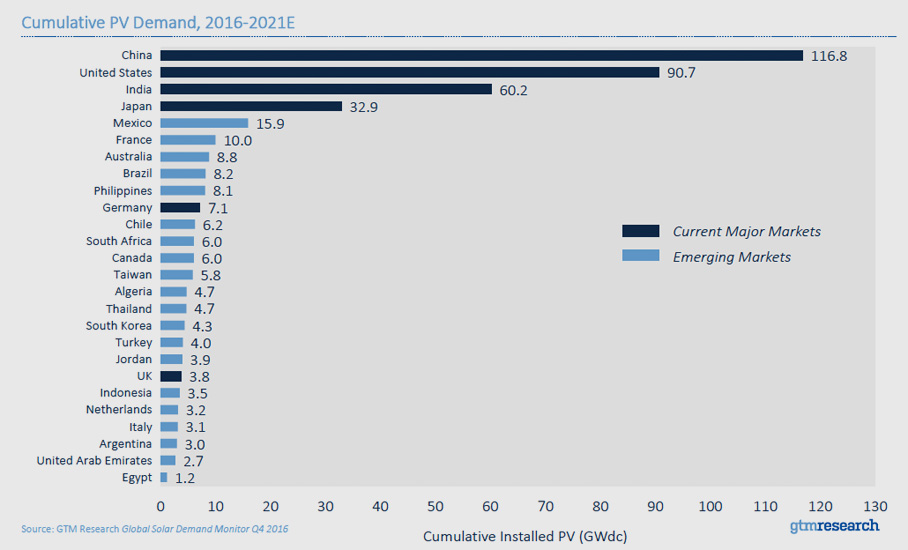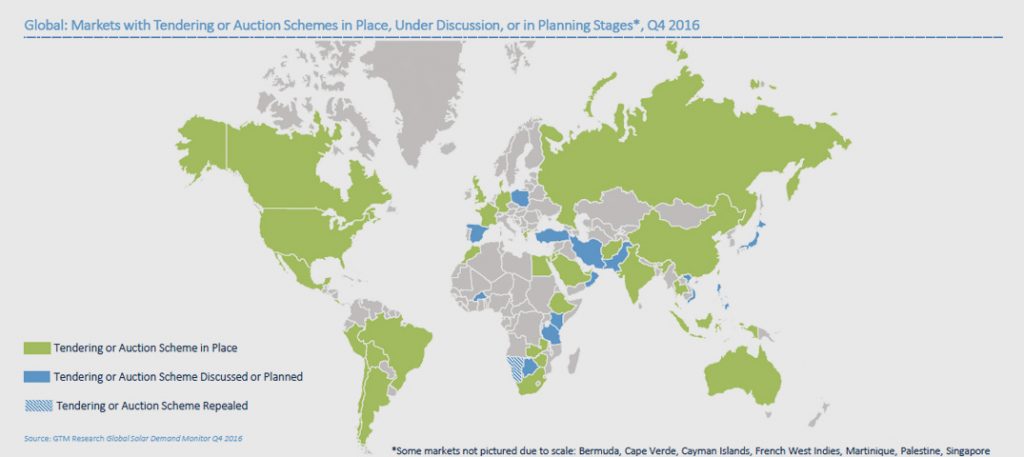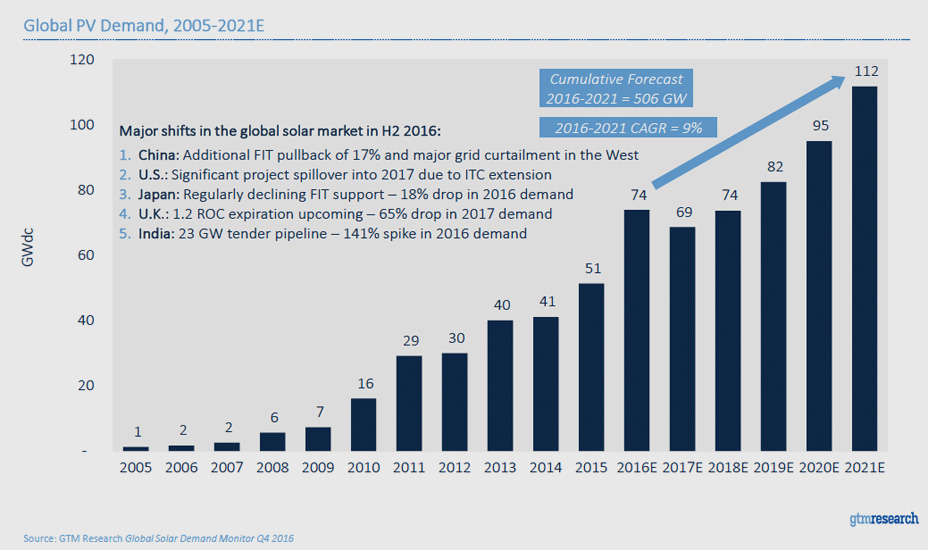Global Solar Demand: Still Shrinking, But at a Lower Rate
Solar will contract 7 percent next year, and then post 9 percent compound annual growth through 2021.
Next year’s drop in global solar demand might not be as steep as analysts previously thought, according to GTM Research’s latest Global Solar Demand Monitor.
“Last quarter, we were originally forecasting a 10 percent contraction in the global market in 2017, mainly due to policy shifts in China, Japan, U.K. and Germany,” said GTM Research global solar markets research associate Benjamin Attia, author of the Q4 Demand Monitor.
Low module prices, a pipeline shift for utility-scale solar, and improving demand in India all contributed to the change.
“I’ve raised the forecast slightly so that we’re now expecting a 7 percent contraction. Our cumulative growth rate through 2021 is now at 9 percent,” said Attia.
Solar demand is expected to hit a record 74 gigawatts worldwide this year, with the world’s top five markets — China, U.S., Japan, India and the U.K. — accounting for 80 percent of installations. The market will be back at 2016 levels by 2018, GTM Research predicts.
Next year’s installations will be the second-largest ever seen, “helped along by triple-digit growth in India and nearly flat growth in the United States and global module oversupply conditions leading to falling module ASPs [average selling prices],” according to the report.
graphic 01
A breakdown of demand by country reveals three distinct market groups: current major, emerging and post-mature.
The current major markets, namely China, United States and India, amounted to 75.9 gigawatts of installations between 2001 and 2015. And they are set to continue booming, adding a further 267.7 gigawatts collectively up until 2021.
Meanwhile, a number of post-mature major markets, including Germany, Japan, Italy and the U.K., have more or less peaked in terms of growth.
They notched up a combined 104 gigawatts of capacity between 2001 and 2015, but will only add a further 46.9 gigawatts up until 2021.
Most of this is due to continued pull in the Japanese market, where 32.9 gigawatts of capacity could get built through 2021. Finally, the demand figures feature an increasingly long tail of emerging markets.
Over the next half decade, this group will be led by Mexico, France and Australia, which together will add 34.7 gigawatts by 2021.
graphic 02
These emerging markets, which include a range of Latin America, Middle East and Asia Pacific nations, are far more likely to rely on capacity bids than feed-in tariffs (FITs) for market growth.
This, combined with a lessening of FIT support in major markets, signals a change in the way utility-scale solar is being procured worldwide, said Attia. “What we’re seeing globally is a big shift from the FIT world to the tender world,” he said.
“It seems to be spreading to smaller markets that are taking lessons from Germany. Some markets, like Mexico, skipped the FIT altogether and went straight to the auction basis. We’re seeing Japan transitioning now, as well as China.”
Countries relatively new to solar power, such as Israel, Turkey or Saudi Arabia, are moving directly to tenders as a way of procuring new capacity.
“Part of the value that they’ve recognized is price competition right away. They’re entering the solar market at a time when prices are already competitive, and they can have a better idea of how much capacity we are allowing onto the grid,” Attia said.
graphic 03
China is deservedly getting a lot of attention. This year is the biggest one ever for solar in the country, and will likely to be the biggest for some time to come.
China is expected to install 28.3 gigawatts of solar in 2016, more than twice the amount of capacity of the United States, its nearest competitor. But demand will plummet 40 percent next year, and will not return to current levels in the foreseeable future.
In any case, this year’s surge will put China so far ahead of other solar markets that it will be difficult for others to catch up. Between 2016 and 2021, Chinese solar demand will amount to 116.8 gigawatts — well ahead of America’s 90.7 gigawatts or India’s 60.2 gigawatts.
GTM Research’s figures for the U.S. were calculated before Donald Trump came to power, however. Will the election outcome make a difference?
“It is a little bit too early to tell,” said Attia. “But I think the outlook is largely unchanged. There is a clear recognition of the opportunity solar presents.”










